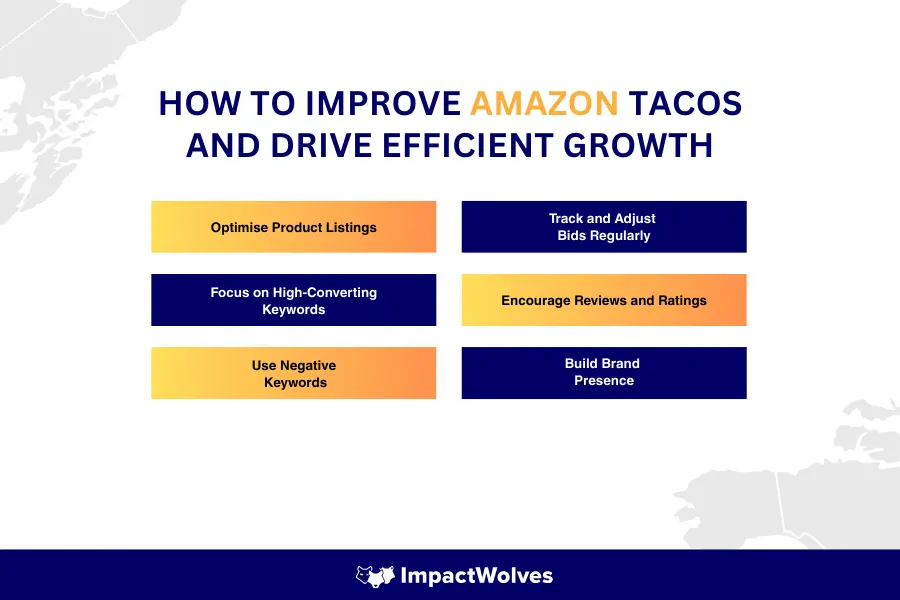Running ads like crazy, but sales aren’t moving? Your ads might not be the problem. The way you’re tracking results might be.
Heard about TACoS? This is what you need to track real performance and make smarter ad choices. It shows how ads affect all your sales, not just the ones from clicks. You will get a clear view of what’s working and what’s not.
This guide will break down what TACoS means, how to calculate it, and why it matters.
Part 1: Understanding Amazon TACoS: Total Advertising Cost of Sales
1. What Is Amazon TACoS?
Amazon TACoS (Total Advertising Cost of Sales) is a metric used to measure the overall impact of your ad spend on total sales, including both ad-attributed and organic sales. It gives a broader view of how advertising efforts influence your entire business, not just the sales directly generated by ads.
Your TACoS is directly influenced by spending, as outlined in the Amazon Advertising Cost in 2025 guide.
Definition:
Amazon TACoS shows what percentage of your total revenue (ad + organic) is being spent on advertising.
Formula:
TACoS = (Ad Spend ÷ Total Sales) × 100
-
- Ad Spend includes what you pay for Amazon ads.
-
- Total Sales include both sales generated from ads and those that occurred organically.
Example:
If you spend $100 on ads and generate $2,000 in total sales:
TACoS = (100 / 2000) × 100 = 5%
2. Why Amazon TACoS Matters
Amazon TACoS (Total Advertising Cost of Sales) is important because it measures how your advertising spend affects your entire sales performance, including both ad-attributed and organic sales. Amazon TACoS gives a broader view of profitability and long-term growth.
Key Reasons Amazon TACoS Is Valuable:
-
- Holistic View of Performance
Amazon TACoS includes all sales, not just those generated through ads. This helps you understand the full impact of your advertising efforts.
- Holistic View of Performance
-
- Insight Into Organic Growth
A declining Amazon TACoS may indicate that ads are helping improve your organic visibility and rankings, meaning you’re becoming less reliant on paid traffic.
- Insight Into Organic Growth
-
- Smarter Budget Decisions
By monitoring TACoS trends, sellers can determine when to scale up, maintain, or reduce ad spend based on overall performance.
- Smarter Budget Decisions
-
- Improved ROI Understanding
TACoS helps track whether your total revenue justifies the ad spend, making it easier to evaluate true profitability.
- Improved ROI Understanding
Example:
If your Amazon TACoS is dropping over time while sales remain stable or increase, it suggests that your organic sales are improving. Your ad campaigns are contributing to long-term visibility, not just immediate purchases.
If you’re also working on improving your overall advertising efficiency, our PPC tips to help drive results on Amazon can give you actionable ideas that align perfectly with your TACoS goals.
Part 2: How to Improve Amazon TACoS and Drive Efficient Growth
Improving your Amazon TACoS means increasing overall sales especially organic sales while keeping ad spend in check. A lower TACoS generally reflects a healthy balance between advertising and organic visibility.
Key Ways to Improve TACoS:
Optimise Product Listings
Enhance titles, bullet points, images, and keywords to improve your product’s organic ranking and conversion efficiency, thereby reducing your reliance on ads.
If you’re looking to improve your product listings to support organic growth and lower TACoS, this Amazon listing optimization guide by HubSpot walks you through proven techniques.
Focus on High-Converting Keywords
Target keywords with strong performance data. Pause or remove low-performing ones to prevent wasted ad spend.
Use Negative Keywords
Block irrelevant search terms to avoid spending on unqualified traffic.
Track and Adjust Bids Regularly
Monitor performance by campaign and reduce bids on underperforming terms. Allocate more budget to keywords that contribute to both paid and organic growth.
Encourage Reviews and Ratings
A well-reviewed product is more likely to perform well organically, helping reduce dependence on paid ads.
Build Brand Presence
The more familiar customers are with your brand, the more likely they are to purchase without clicking on an ad.
What TACoS Percentage Is Considered Good or Bad?
A lower TACoS is generally preferred, as it indicates that a smaller portion of your revenue is being spent on ads and a larger share is coming from organic sales. However, what’s considered “good” or “bad” depends on your product stage, goals, and margins.
Good TACoS Ranges
-
- Below 10%:
Strong performance. Suggests high organic sales and lower ad dependence.
- Below 10%:
-
- 10–15%:
Typically healthy for established products with a balanced sales mix.
- 10–15%:
-
- 15–20%:
Acceptable for many sellers, especially during growth phases or seasonal pushes.
- 15–20%:
To explore this further, read our complete guide on how TACoS impacts your Amazon advertising strategy.
Part 3: Step-by-Step: How to Calculate Your TACoS
TACoS calculation is very simple. You just need two numbers: your total ad spend and your total sales. If you have them, you can use the following formula:
Formula:
TACoS = (Ad Spend ÷ Total Sales) × 100
Let’s understand it through a step-by-step guide!
Step 1:
Find your Ad Spend. Let’s say your ad spend is $500 on Amazon ads.
Step 2:
Now find your Total Sales, including both ad + organic. Let’s take $5,000 as total sales.
Step 3:
Next, you need to plug the numbers into the formula. Here it goes:
TACoS = (500 ÷ 5000) × 100
Step 4:
Do the math:
500 ÷ 5000 = 0.10
0.10 × 100 = 10%
Your Amazon TACoS is 10%. This means 10% of your total revenue went to ads.
If you need help to manage this on a bigger scale, check out this Amazon PPC management guide to stay on top of your ad spend.
Now that you know how to calculate TACoS, it’s time to put it to work.
Part 4: Using TACoS Trends to Adjust Your Advertising Strategy
The job doesn’t end at just finding the Amazon TACoS. You should track them to make smarter ad decisions. It shows how your ad spend is affecting the total performance of the business. Here is how you can use TACoS trends:
Rising TACoS:
This probably means that your ads are neither efficient nor generating sales. Check for high spend with low returns. Stop using weak keywords or fix the listing issues. These two are major factors that hurt conversion.
Stable or Low TACoS:
If your TACoS calculation is steady or declining, it is a good sign. This means your organic sales are growing. This may be the right time to scale your ad budget carefully. Just make sure your backend operations are solid too, including proper Amazon FNSKU labeling.
Look at Other Metrics Too:
No doubt, TACoS lets you see the bigger picture, but you don’t have to stop there. Combine it with key metrics like Click-Through Rate (CTR) and Conversion Rate (CVR). With these values, you can analyze what is actually working and what needs to be fixed.
For a more complete view of ad performance, you might also find our guide to tracking your ACOS on Amazon useful alongside TACoS, CTR, and CVR.
Final Thoughts
Amazon TACoS not just helps you see what ads bring in, but also how they support your total sales. A good TACoS means your ads are working without eating up profits. If they are too high, it’s time to adjust. Too low? Maybe you can scale.
Start with the basics, know what TACoS is, how to track it, and what the numbers mean. Keep your product pages strong. Watch your keywords and make smart changes as you go. TACoS gives a full view of ad impact. Monitor regularly, aim for balance. Simple as that! Need help avoiding common ad mistakes? Check out these 9 PPC slip-ups.
Faqs
What is a good TACoS percentage on Amazon?
A TACoS between 5% and 10% is generally considered ideal. These figures show a good mix between overall sales and advertising expenses. A TACoS of 10% to 15% can also be reasonable for mature products.
Is TACoS more important than ACoS?
TACoS basically compares your ad spend to all your sales, including organic and ad sales. ACoS, on the other hand, focuses only on sales that came directly from ads. Both metrics are important. One shows how ads are helping your whole business grow. While other tells how well your ads are doing on their own. Want a clear breakdown? This ACoS vs TACoS guide explains it in a simple way.
If you’re tracking TACoS, it’s also helpful to understand how ACoS measures direct ad performance. This ACoS guide breaks it down clearly
Can TACoS be negative?
No, TACoS can’t be negative. It’s based on ad spend and total sales, both of which are positive numbers. So, the result of Amazon TACoS will always be zero or positive.
How often should I check my TACoS?
One should calculate TACoS every week or two. This helps spot changes early, and you can adjust your ads if needed. Also, regular checks make it easier to track your sales and ad performance. If you’re running ads, avoid these common Amazon PPC mistakes that could mess up your numbers.







